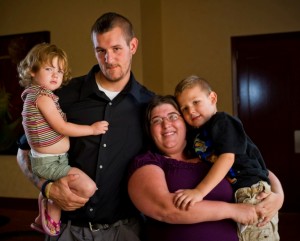By Alan Morales, WTC Stratcom

AW2 spouse Danielle Barber and her husband AW2 Veteran Rob Barber at the 2011 AW2 Symposium.
Danielle Barber was sitting across the table from me at lunch when I first met her at the 2011 AW2 Symposium. She had a big smile on her face and an infectious laugh that spread around the table.
Little did I know that behind that upstate New York smile was a woman who fights daily for something she believes in—her marriage. Danielle is the spouse of an Army Guardsman and lives a life that is different than that of her fellow wounded warrior active duty wives. She didn’t have the benefit of living on post. She was not welcomed by a Family Readiness Group at her doorstep. All she had was the love for her husband to keep driving her forward. And to this day—it still does.
I learned from Danielle that her husband, Rob, sustained a traumatic brain injury (TBI) and post-traumatic stress disorder (PTSD) in 2006. As a gunner, Rob’s job kept him in the midst of battle, and his daily routine continuously exposed him to the rawness of war. Danielle doesn’t know exactly what happened to her husband downrange, but as she explained to me, “I don’t need to know. I need to let him deal with the reality of his own experience.” However, she was aware of one thing. War changed him into a different man.
Danielle described her relationship with Rob pre-deployment as a romantic one. She looked away from me as she attempted to envision their relationship years ago. “He used to call me cupcake and hold my hand when we walked down the street,” she explained, as she wiped a tear away from her cheek. Rob’s experiences had a lasting effect on him, one he tried to change, but was out of his control.
Danielle explained, “I could handle the lead up to the war, I could handle the war itself, but it was the life immediately after the war that I couldn’t handle.”
Through the years, the Barbers have gone to doctors, therapy sessions, and rehabilitation. All have helped to some degree, but it seems that communication was the catalyst for change. “He has a voice, and I can see that he’s happy. It’s changed him,” said Danielle about Rob’s Symposium experience.
I realized that Rob was looking for an opportunity to share his perspective, experiences, and opinions. The AW2 Symposium enabled him to do just that, not only for himself, but also for those that will follow after him. Although I didn’t hear what he said in the focus groups that day, one thing was sure. He was heard by his fellow wounded warriors.
That evening was date night at the AW2 Symposium, a time for delegate couples to spend time together and reconnect. “I’m nervous. Rob’s been talking so much more since we got here,” Danielle laughed. “We actually had a conversation last night! Who knows what will happen tonight.” I could sense the anxiety in her voice, but also a glimmer of excitement in her demeanor. She leaned in, gripped her hands together, and didn’t say a single word. She just smiled.
The next morning at breakfast, I caught Danielle and Rob before they headed to their focus group session. “So how was the date last night?” I pried. Danielle’s face beamed, and she described everything from the lobster dinner they shared to the walk they had after dinner.
More importantly, she leaned in, and this time told me the three words that explained it all, “We held hands.”
Danielle’s story demonstrated to me that love motivates her and her husband to keep working towards improving their lives as they live with Rob’s injuries. This week, the Barbers are around others like them who face similar situations. This opportunity gives them the ability to see what progress looks like and what their future could possibly look like in the years to come.
Although Danielle is well aware of the challenges that will come down the road, she walked out of breakfast that morning with something much greater than memories of her lobster dinner from the night before. She left with hope.











